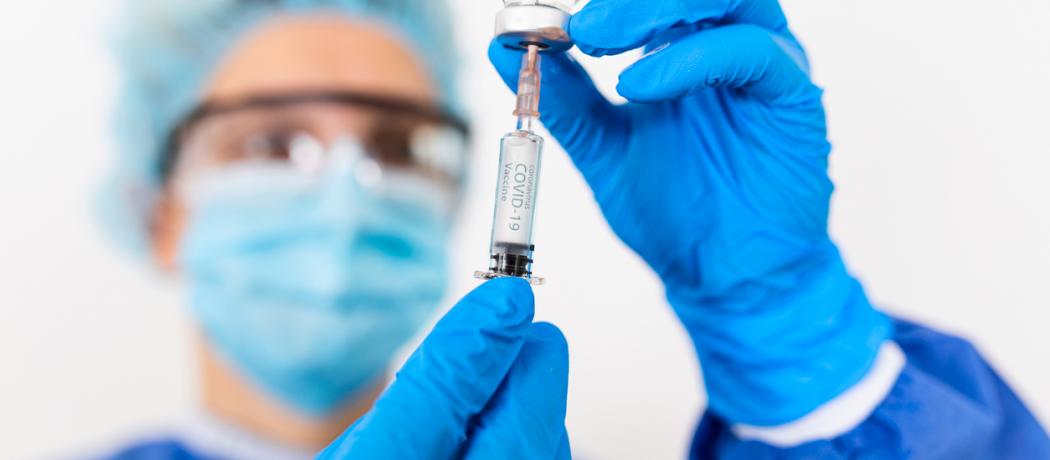The current Pfizer-BioNTech vaccine injection methods are simple: withdraw from the vial 0.30 mL of fluid, insert the needle into the deltoid muscle, inject, withdraw the needle, discard the syringe/needle into the disposal bin—done. However, this discards about 0.08 mL of fluid left in the dead space of the standard 25 g 1.5 inch syringe/needle.
When you draw up 0.30 mL of fluid into a syringe, you are actually drawing up 0.38 mL; the extra 0.08 mL in the dead space amounts to about 20% of vaccine material being discarded. If using the new high-efficiency low dead space syringe recommended by Pfizer-BioNTech, which has a dead space volume of 0.035 mL, that is still about an 11% loss for a 0.30 mL injection [Figure 1].
The Moderna vaccine is injected in 0.5 mL increments using the standard injection syringes/needles and methods, which requires drawing up 0.58 mL of fluid (this includes 0.08 mL in the dead space). The fluid left in the dead space amounts to about 14% being discarded.
The loss of vaccine material due to an inefficient injection technique is enormous, but a simple remedy exists. How can you use that 0.08 mL of fluid from the dead space?
Here is a simple example of how to measure the dead volume. When you load a syringe to 0.30 mL, you are actually drawing back 0.38 mL. Fill the syringe to the 0.30 mL mark, clear any air from the syringe/needle, then simply eject the 0.30 mL. Next, draw air back into the syringe and note the amount of dead space fluid volume you drew back into the syringe. A 25 g 1.5 inch needle will hold 0.08 mL [Figures 2, 3].
How to use the dead volume fluid
For the Pfizer-BioNTech vaccine, draw up 0.22 mL into the barrel of the syringe, noting that there is 0.08 mL in the dead space (0.22 + 0.08 = 0.30). Then draw up an additional 0.2 mL or thereabouts of air. Tap the air to the top of the syringe barrel. When injecting, face the needle downward so the air is the last bit to be injected—it flushes the 0.8 mL out of the dead space so that the entire compliment of 0.30 mL is used without the dead space fluid being discarded.
How safe are intramuscular air injections?
This subject has undergone extensive anecdotal studies since about 1913, mostly in military, nursing, and anesthetic publications. Although intravenous air embolism of large volumes of air has serious adverse cardiac outcomes, low volume intramuscular air injections, either incidental or purposeful, are considered harmless. A bit of dead volume air in the syringe can confuse the dosage calculation, that’s all [Figures 4,5].[1-4]
For the Moderna, AstraZeneca, Johnson & Johnson, and Novavax vaccines, which inject 0.50 mL, the technique is the same. Draw up 0.42 mL of vaccine into the syringe, draw another 0.2 mL or so of air, which pulls the dead space vaccine into the syringe barrel for a total 0.50 mL of vaccine with air tapped to the top. Inject downward so the air flushes the dead space into the muscle. This method can be used with any combination of needles and syringes. If using a needle/syringe different than the version discussed above, calculate the dead space volume for the specific syringe type in order to determine how much vaccine to draw into the syringe.
It has been stated that there are 84 million injections planned for Canada, presumably of a mix of vaccine types. If we save from 0.035 to 0.080 mL per dose, on a conservative average among the vaccine types injecting let’s say 0.40 mL per dose, that represents a saving of about 1 344 000 extra doses available for Canadian arms (84 M × 0.04 × 0.40). On a global scale, with 5 billion people (roughly estimated) wanting to be vaccinated with two doses, that 0.04 mL of savings per shot equals an extra 160 million injections.
This is a sampling of what could be saved by using an injection savings technique; what actually happens in the world will probably be different due to issues such as vaccine type, vial size, needle/syringe type, and other unforeseen issues.
—Murray E. Allen, MD

Figure 1. The usual withdrawal of 0.30 mL of fluid (red wine in this illustration) into a standard 25 g 1.5 inch syringe/needle leaves 0.08 mL in the dead space of the needle housing.

Figure 2. When 0.30 mL plus the 0.08 mL from the dead space is drawn into the syringe, the needle housing is empty.

Figure 3. The dead space volume after ejecting all the fluid noted in Figure 2 and then withdrawing air to pull the dead space volume back into the syringe, here showing 0.08 mL.

Figure 4. Withdrawal of fluid to the 0.22 mL mark, recognizing that 0.08 mL is still in the dead space. Total fluid withdrawn = 0.30 mL.

Figure 5. Shows the image in Figure 4 with the addition of about 0.2 mL of air drawn into the syringe and tapped to the top of the barrel. This air flushes the entire 0.30 mL into the intramuscular space.
References
1. Wilkins RG, Unverdorben M. Accidental intravenous infusion of air: A concise review. J Infusion Nurs 2012;35:404-408.
2. Rohilla P, Khusnatdinov E, Marston JO. Effect of air pockets in drug delivery in jet injections. Preprint. 2021. https://researchgate.net/publication/349022777.
3. Adornato DC, Gildenberg PL, Ferrario CM, et al. Pathophysiology of intravenous air embolism in dogs. Anesthesiology 1978,49:120-127.
4. Chan VO, Colville J, Persaud T, et al. Intramuscular injections into the buttocks: Are they truly intramuscular? Eur J Radiol 2006;58:480-484
This post has been peer reviewed by the BCMJ Editorial Board.


